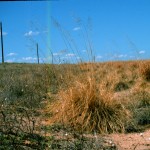Weeping Lovegrass
Eragrostis curvula
Poaceae
Description
Originally introduced as a soil stabilizer from South Africa, this clump-forming grass’s stems are erect up to 5 ft or 1.5 meters. The name, Weeping Lovegrass, was based on the way its basal leaves curve backward toward the ground. Its leaves are narrow (<1.5 mm), long (up to 30 cm), taper to a fine point, droop, and rough on the bottom and top surfaces. The basal leaves are much longer than those further up the stem. Sheaths are covered on the back and near the base with long, soft, and shaggy hairs. The inflorescence is a loose, open pyramidal panicle with grayish-green spikelets containing many seeds. The panicle can be up to 40 cm long by 15 cm wide. There are numerous (6-12) florets per spikelet. Spikelets are not found proximally on the branches. Branch axils have a fringe of hairs up to 2.5 mm long. Weeping Lovegrass is a perennial, warm-season, introduced grass providing fair grazing for livestock but poor grazing for wildlife.Habitat
This grass prefers sandy soil. It is a native of South Africa. Weeping Lovegrass is highly drought tolerant and does best in well-drained sandy loams. It can be found in waste areas, roadsides, and occasionally in woodlands and forests. Originally used for re-vegetation, it has escaped into other areas. Recently, it has become popular as an ornamental.Images
Plant Characteristics
Seed Type: Non-Encapsulated
Duration: Perennial
Stem Texture: Hairy
Growth Habit: Bunch grass, Grasses
Season: Warm
Distribution
 : 03 - Post Oak Savannah, 04 - Blackland Prairies, 05 - Cross Timbers and Prairies, 08 - Rolling Plains, 09 - High Plains
: 03 - Post Oak Savannah, 04 - Blackland Prairies, 05 - Cross Timbers and Prairies, 08 - Rolling Plains, 09 - High Plains
Distributions
Distribution refers to the ecological region in Texas that a plant has been found. You can also view a clickable map.
Book: Know Your Grasses (B-182)
Collection: Grasses



